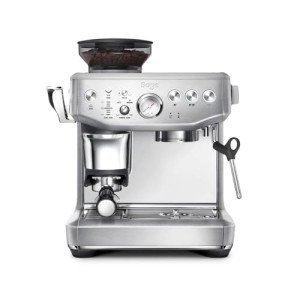Heat Exchange Espresso Machines: A Comprehensive Guide
Espresso machines have actually developed significantly for many years, accommodating the needs of home baristas and coffee experts alike. Amongst these machines, heat exchange espresso machines have actually acquired appeal due to their ability to deliver consistent performance and exceptional brew quality. In this short article, we will explore the functions, advantages, and important features of heat exchange espresso machines, supplying a comprehensive understanding for both possible purchasers and coffee lovers.
Understanding Heat Exchange Technology
Heat exchange espresso machines run on a special principle that permits synchronised water heating for developing and steaming. click to read are geared up with a single boiler that uses a heat exchanger system. This function is substantial as it enables users to brew espresso while steaming milk simultaneously, promoting effectiveness in the coffee-making procedure.
How Does a Heat Exchange Espresso Machine Work?
The process begins with the machine's water inlet filling the boiler. As the water warms up, it turns to steam. The ingenious heat exchanger uses hot steam to heat additional water in a separate passage developed specifically for the brew group. This means that water can reach the perfect brewing temperature level without waiting on the boiler to adjust. The essential steps consist of:
- Water Fill: Water is drawn into the boiler.
- Heating Process: The boiler warms up as water is transformed into steam.
- Heat Exchange: Steam heats water in the heat exchanger tube.
- Developing: Water from the heat exchanger is pushed through coffee premises, drawing out the flavors needed for an abundant espresso.
This procedure permits for quick temperature changes and enhanced coffee extraction.
Advantages of Heat Exchange Espresso Machines
Heat exchange espresso machines provide numerous advantages, particularly for those wanting to optimize their coffee experience. Here are some key advantages:
- Simultaneous Brewing and Steaming: Users can brew espresso while steaming milk, making it ideal for busy coffee shops and home baristas who value efficiency.
- Temperature level Stability: The boiler's steam pressure helps maintain a steady temperature, which is crucial for consistent espresso extraction.
- Versatility: The design enables quick changing between brewing and steaming, making it much easier to produce numerous coffee drinks, from lattes to cappuccinos.
- User-friendly: Models often come with accessible controls, making it possible for both beginners and skilled baristas to produce quality drinks.
- Professional Quality: Heat exchange machines are often utilized in commercial settings, supplying users with high-quality brewing efficiency at home.
Secret Features to Look for in Heat Exchange Espresso Machines
When considering the purchase of a heat exchange espresso machine, there are numerous functions that a person need to take into account:
- Build Quality: Look for machines made from resilient materials, such as stainless-steel or brass, ensuring durability.
- Boiler Size: A bigger boiler will hold more water and sustain greater output over time.
- PID Temperature Control: This feature helps preserve consistent brew temperatures, which can boost the coffee-making process.
- Group Head Design: Machines with a saturated or semi-saturated group head provide much better temperature level stability.
- Reduce of Use: User-friendly user interfaces and intuitive controls boost the overall experience for baristas at all ability levels.
- Steam Wand Quality: An excellent steam wand with appropriate insulation and flexibility permits much better texturing of milk.
- Water Reservoir Size: Depending on your requirements, think about how frequently you wish to refill the water tank.
Contrast of Popular Heat Exchange Espresso Machines
To much better understand the alternatives available in the market, below is a comparison table of some popular heat exchange espresso machines:
| Machine Model | Boiler Size | PID Control | Rate Range | User Ratings |
|---|---|---|---|---|
| Profitec Pro 700 | 2.0 L | Yes | ₤ 2,000-₤ 2,500 | 9.5/ 10 |
| Rocket Espresso R58 | 1.8 L | Yes | ₤ 2,400-₤ 2,800 | 9.4/ 10 |
| Elekta Bianca | 1.8 L | Yes | ₤ 2,500-₤ 3,000 | 9.6/ 10 |
| La Spaziale S1 Vivaldi II | 1.5 L | Yes | ₤ 1,800-₤ 2,200 | 9.2/ 10 |
| Bezzera Magica | 1.2 L | No | ₤ 1,600-₤ 1,800 | 9.0/ 10 |
FAQs About Heat Exchange Espresso Machines
What is the main distinction between a heat exchange and a dual boiler espresso machine?
While both types can brew espresso and steam milk at the exact same time, dual boiler machines have different boilers for developing and steaming. On the other hand, heat exchange machines use a single boiler and a heat exchanger to accomplish the same function.
Are heat exchange machines ideal for beginners?
Yes! Numerous heat exchange machines are designed with user-friendly functions, making them available for novices. With appropriate assistance and practice, users can quickly produce quality espresso.
What sort of maintenance do heat exchange espresso machines need?
Regular upkeep includes descaling, cleaning the boiler, examining seals and gaskets, and keeping the group head clean. Routine upkeep guarantees longevity and constant efficiency.
Can I use a heat exchange machine for different kinds of coffee drinks?
Absolutely! Heat exchange machines enable users to produce a variety of coffee beverages, including espresso, lattes, coffees, and more.
Heat exchange espresso machines represent a mix of innovation and custom, supplying coffee lovers with the tools required for crafting the best cup. Their capability to at the same time brew and steam, integrated with accurate temperature level control, makes them a compelling choice for both home baristas and specialists. With the best understanding on features and maintenance, users can open a world of elegant coffee experiences, guaranteeing that each sip is as delightful as the last.

